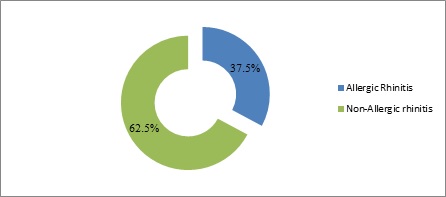The diagnostic utility of Serum IgE and Absolute eosinophil count in cases of Allergic Rhinitis
Abstract
Introduction: Allergic rhinitis is the commonest allergic disease in India. Eosinophils have been long associated with allergies. Serum IgE levels are also used as a parameter to support the diagnosis of the same. Both absolute eosinophil count (AEC) and serum IgE are a part of basic investigation panel for allergies and are known to be positively related with it. Thus, this study was taken up to determine the diagnostic utility of Serum IgE and absolute eosinophil count in cases of Allergic rhinitis.
Methodology: This was a two-year prospective study conducted on 105 cases, clinically diagnosed as allergic rhinitis. Absolute eosinophil count and total serum IgE were recorded for all the cases. Diagnostic utility of each parameter was determined using appropriate statistical tests. Results were tabulated and assessed.
Results: Among 105cases, 44.8% were females and 55.2% were males, with mean age of 29.8years. Peripheral blood eosinophils >6% were seen in 42% cases. Of the total cases, Absolute eosinophil count was increased>450cells/cu mm in 49 (46.6%) cases and Serum IgE was elevated >120IU/ml in 73(69.5%) cases. Both AEC and Serum IgE together were raised only in 39(37.1%) cases.
Conclusion: Thirty-nine (37.1%) cases showed simultaneous increase in AEC and Serum IgE. The outcomes of both tests when considered together did not significantly affect the diagnosis of Allergic rhinitis. However, individually, 49 (46.6%) cases had a high absolute eosinophil count and Serum IgE was raised in 73(69.5%) cases. Although not significant, testing for Serum IgE levels were found to be more accurate with a better diagnostic utility.
Downloads
References
Mullol J, Valero A, Alobid I, Bartra J, Navarro AM, Chivato T, Khaltaev N, Bousquet J. Allergic Rhinitis and its Impact on Asthma update (ARIA 2008). The perspective from Spain. J Investig Allergol Clin Immunol 2008;18(5):327-334.
Chandrika D. Allergic rhinitis in India: an overview. Int J Otorhinolaryngol Head Neck Surg. 2017;3(1):1-6. doi: http://dx.doi.org/10.18203/issn.2454-5929.ijohns20164801.
Varshney J, Varshney H. Allergic rhinitis: an Overview. Indian J Otolaryngol Head Neck Surg. 2015; 67(2):143–149. doi https://doi.org/10.1007/s12070-015-0828-5.
Tegnoor MS, Jabri OBA, Kumar MV, Kurle V. Assessment of serum IgE levels in patients of allergic rhinitis. Al Ameen J Med Sci. 2017;10(2):136-140.
Srivastava T, Shamanna K, Viswanatha B. Role of IgE and Absolute Eosinophil Count as Prognostic Markers to Determine the Optimum Duration of Therapy in the Management of Seasonal Allergic Rhinitis. Res Otolaryngol. 2018;7(2):36-42. doi: https://doi.org/10.5923/j.otolaryn.20180702.03.
Jagadeeshwar K, Venumadhav V, Sangram V, Chowdary S. Rani S, Vijaykumar EC. A study on serum IgE levels, peripheral eosinophils and individual symptoms in patients with non-infective rhinitis and asthma and related conditions. Int J Pharm Pharm Sci. 2012;4(1):88-92.
Chowdary VS, Vinaykumar EC, Rao JJ, Rao R, Ram Babu K, Rangamani V. A Study on Serum IgE and Eosinophils in Respiratory Allergy Patients. Indian J Allergy Asthma Immunol. 2003;17(1):21-24.
Shaik WA. Allergies in India: An analysis of 1619 patients attending an allergy clinic in Bombay, India. Int. Rev. Allergol. Clin. Immunol. 1997; 3(2):101-104.
Okano M, Nishizaki K, Nakada M, Kawarai Y, Goto S, Satoskar AR, et al. Prevalence and prediction of allergic rhinitis using questionnaire and nasal smear examination in school children. Acta Otolaryngologica. 1999;540:58-63. doi: https://doi.org/10.1080/00016489950181215.
Wittig HJ, Belloit J, De Fillippi, Royal G. Age related immunoglobulin E levels in healthy subjects and in patients with allergic diseases. J. Allergy ClinImmunol. 1980;66(4):305-313. doi: https://doi.org/10.1016/0091-6749(80)90026-3.
Merret TG, Burr Mh, Stleger AS, Merret J. Circulating IgE levels in the over seventies. Clinic All. 1980;10(4):433-439. https://doi.org/10.1111/j.1365-2222.1980.tb02126.x.
Demirjian M, Rumbyrt JS, Gowda VC, Klaustermeyer WB. Serum IgE and eosinophil count in allergic rhinitis-Analysis using a modified Bayes’ theorem. Allergol Immunopathol (Madr). 2012;40(5):281-287. doi: https://doi.org/10.1016/j.aller.2011.05.016.
Austen FK. Allergies, Anaphylaxis and systemic Mastocytoses. In. Kasper LD, Fauci SA, Longo LD, Braunwald E, Hauser LS, Jameson LJ. Harrison’s Principles of Internal Medicine. 18thed. New York: McGraw-Hill; 2012; 1:2715-2718.
Halonen M, Barbee RA, Lehanitz MD, Eurrows B. An epidemeologic study of the interrelationship of total serum immunoglobulin E, Allergy skin reactivity and eosinophils. J Allergy Clin. Immunol. 1982;69(2):221-228. doi: https://doi.org/10.1016/0091-6749(82)90103-8.
Di Lorenzo G. Mansuetop, Melluso M, Morici G, Norrito F, Esposito Pellitteri M, et al. Non-specific airway hyperresponsiveness in monosensitive sialian patients with allergic rhinitis: Its relationship to total serum IgE level and blood eosinophils during and out of the pollen season. Clin Exp Allergy. 1997;27(9):1052-1059. doi: https://doi.org/10.1111/j.1365-2222.1997.tb01257.x.

Copyright (c) 2020 Author (s). Published by Siddharth Health Research and Social Welfare Society

This work is licensed under a Creative Commons Attribution 4.0 International License.


 OAI - Open Archives Initiative
OAI - Open Archives Initiative


